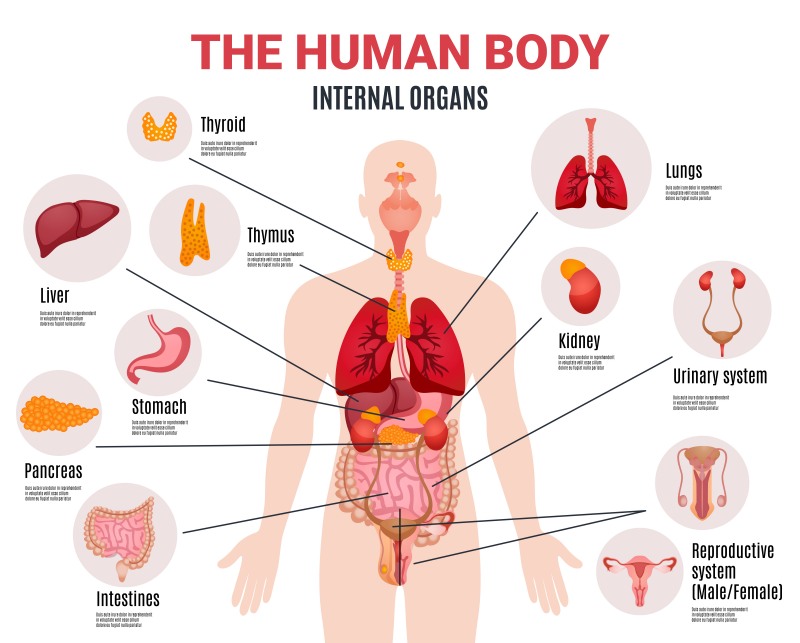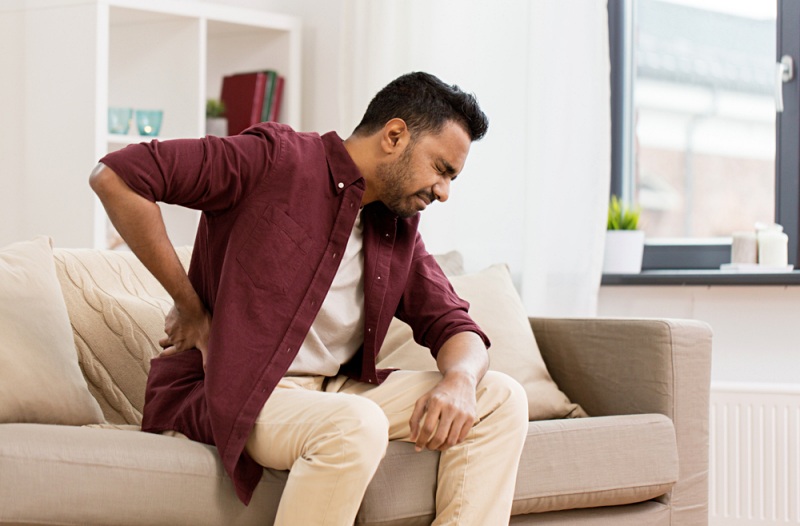Do you feel left side pain under your ribs? How long has the pain been there? Do you know the source of the pain? Let's track down some likely suspects.
RELATED: 10 Signs of Kidney Problems You Need to Watch Out For
What Causes Left Side Pain under Ribs

Rib Pain Left Side Anatomy

The organs that sit on the left side may include:
- left lung
- heart
- stomach
- pancreas
- left kidney
- intestines
- spleen
It's also possible for the pain to radiate or refer. This means that left side pain under the ribs may come from another area of your body.
For example, a sign of a heart attack is pain along the jaws or teeth. The site of the pain is far from the source, and you might mistake it for a dental issue.
Rib Injuries

Did you have a rough spill recently? Did you receive a blow to your ribs or chest area? You might be suffering from a broken rib.
Symptoms of rib injuries may include:
- pain radiating from the injured rin
- pain when you move, breathe, laugh, sneeze, or cough
- grinding or crunching sounds when you move
- muscle spasms
- deformed appearance around the chest
- difficulty breathing
Your doctor may diagnose your injury through a physical exam or x-ray. And if your doctor does spot a rib injury, treatments may include:
- rest
- cold compress
- pain killers
- non-steroidal anti-inflammatory drugs (NSAIDs)
- avoiding physical activities
- mechanical ventilation
Unfortunately, you can't patch up your lungs with a cast. So the best way to help your ribs recover is to rest.
Costochondritis

Left side rib pain might feel like a heart attack. That's the case with costochondritis.
Costochondritis is when the cartilage that connects your rib bone and breastbone is inflamed. It usually occurs on your left side and could affect more than one rib bone.
Symptoms of costochondritis may include:
- heavy pressure
- sharp pain
- pain is worse when you breathe or cough
Your doctor may physically examine you and feel around your rib cage for signs of trouble. If you do have costochondritis, treatments may include:
- non-steroidal anti-inflammatory drugs (NSAIDs)
- narcotics (only for severe pain and only with a prescription)
- antidepressants (to help manage chronic pain)
- anti-seizure medications (may also help manage chronic pain)
Hernia

Your muscles protect your organs. But when an organ sticks out of your muscles or tissue, that is called a hernia.
In addition to seeing a bulge in your crotch region, you may experience symptoms like:
- pain at the site
- pain while doing some heavy lifting
- dull aching sensation
- feeling full
- bowel obstruction
Other reported symptoms might include:
- pressure
- cough
- heartburn
- difficulty swallowing
- vomiting
- constipation
Depending on what time of hernia you may have, you might not experience any symptoms.
Your treatment might involve dietary and lifestyle changes. Your physician may also recommend medicine to help you manage your symptoms. Watchful waiting is a medical term where if a condition is asymptomatic or does not seem problematic, a surgeon may decide not to perform surgery.
However, if your hernia doesn't improve or gets worse, you may be a candidate for surgery. A surgical mesh could help strengthen your muscle walls and lower your likelihood of a recurring hernia.
Enlarged Spleen

An enlarged spleen isn't a disease but is a symptom of more serious conditions.
- viral infections
- bacterial infections
- parasitic infections
- liver diseases
- hemolytic anemia
- metabolic disorders
- autoimmune conditions
- cancers
It's also quite hard to catch. You might only discover it during a routine physical exam or imaging tests. But when you do experience symptoms, it may include:
- feeling a dull pain
- feeling full
- being anemic
Treating an enlarged spleen begins with treating the root cause. However, if it's not possible, your doctor may recommend removing the spleen. You can still live normally without a spleen, but you may be at higher risk of dangerous infections.
Heartburn

Heartburn is very easy to confuse with chest pain.
It may be worse after meals, at night, or when you're lying down. You might even taste something acidic or bitter in your mouth.
Fatty foods, acidic foods, carbonated drinks, and caffeinated drinks might trigger your heartburn. Foods like peppermint and chocolate also cause heartburn.
Heartburn is usually easily resolved through dietary changes and medication like:
- antacids
- H-2-receptor antagonists (H2RAs)
- proton pump inhibitors
In most cases, you don't need to go to a doctor for your heartburn.
- experiencing heartburn over two times a week
- if your heartburn medication does not work
- difficulty swallowing
- nausea or vomiting
- difficulty eating
Keep in mind that heartburn might be a symptom of not just an acidic diet, but of acid reflux.
RELATED: How to Fix Wrist Pain for Good
GERD

GERD is severe acid reflux. And one of the symptoms is heartburn.
It stands for gastroesophageal reflux disease and it happens when your stomach acids constantly climb up your esophagus, irritating its lining. Because of this, it might feel similar to chest pain.
Other symptoms of GERD include:
- burning sensation (typically after meals or at night)
- difficulty swallowing
- regurgitating food
- a lump in your throat
Like heartburn, you can treat and resolve GERD by adjusting your diet and lifestyle and taking medication. But in more severe cases, treatment options include:
- fundoplication
- LINX device
- transoral in-cisionless fundoplication
Gastritis

Gastritis happens when your stomach lining becomes inflamed. It may come from bacteria and may also be triggered by your diet and lifestyle.
Symptoms of gastritis may include:
- burning stomach pain
- belching
- hiccups
- nausea, vomiting
- appetite loss
- blood in your stool or vomit (signs of a bleeding stomach)
Treating your gastritis includes changing your diet, avoiding irritating foods, alcohol. Your doctor may also ask you to eat smaller meals to avoid stretching your stomach, which could cause pain.
If your gastritis is caused by your diet, your doctor may put you on a restrictive diet and prescribe antacids and drugs to reduce stomach acids and help your stomach heal.
If your gastritis is caused by bacteria, you might be asked to take antibiotics as well.
Kidney Stones

When they are big enough, kidney stones could be painful. Imagine a sharp stone scratching the walls of your organs.
- sharp pain below your ribs
- pain that extends to your groin
- fluctuating pain
- burning sensation while peeing
- colored urine (pink, red, or brown)
- smelly urine
- cloudy urine
- nausea
- vomiting
If your kidney stones are small and don't cause much trouble, you might get away with drinking plenty of water, pain relievers, and drugs that help you pass kidney stones.
However, if your kidney stones are too big, you may undergo procedures like:
- surgery
- extracorporeal shockwave lithotripsy
- using a scope to break down the kidney stones
- parathyroid gland surgery
Kidney Infection

A kidney infection may feel like abdominal pain.
It's a serious, time-sensitive condition. So if you feel like you exhibit the symptoms below, call your doctor immediately:
- fever
- chills
- side, back, or groin pain
- abdominal pain
- frequent urination
- the constant need to urinate
- burning sensation while urinating
- nausea
- vomiting
- blood or pus in your urine
- smelly urine
- cloudy urine
As it could lead to kidney damage and could travel down your bloodstream, it's important to get it treated as soon as possible.
- antibiotics
- hospitalization
- surgery
Left Side Pain under Ribs—Should I Be Worried?

Go to your doctor if you experience the following in addition to your pain:
- constant pain
- dizziness
- feeling like you're going to pass out
- irregular/rapid heartbeats
- unintentional weight loss
- fatigue
- severe sweating, cold sweats
- swelling
- rashes
- fever
- skin changes
Check out this video to learn more on what causes pain on left side under ribs:
Left side pain under the ribs could come from injuries, muscle pain, or more serious conditions.
There are no strict guidelines when it comes to seeing your doctor. If there is something you're worried about—life-threatening or not—you should feel free to book an appointment with your physician.
Have you ever experienced left side pain under the ribs? Are there other unexplained pains you need help uncovering? Let us know in the comments section below!
Join the healthy living conversation with us on Facebook, Instagram, and Pinterest. We want to hear your story—let's connect via these channels. Find our community online and Join the healthy living revolution today!
You Might Also Like:
- The Link Between Menopause and Joint Pain | Menopause Joint Pain
- How Bicycling Can Relieve Arthritis Pain
- How to Burn Fat While Sleeping | 9 Stress-Free Ways to Burn Fat While Sleeping
Please stay connected with us on Facebook, Twitter, Instagram, and Pinterest, and make sure to join our community of healthy living and minded people here.
Trending
Comfort Food Cravings: A Healthier Way to Balance Winter Eating
Mindful Black Friday Shopping: Save Big While Staying Zen!
Get Updates
SIGN UP FOR OUR NEWSLETTER TODAY

How To Build Your Endurance And Stamina

How to Last Longer in Bed and Enjoy Better Sex!

Related

How To Build Your Endurance And Stamina

